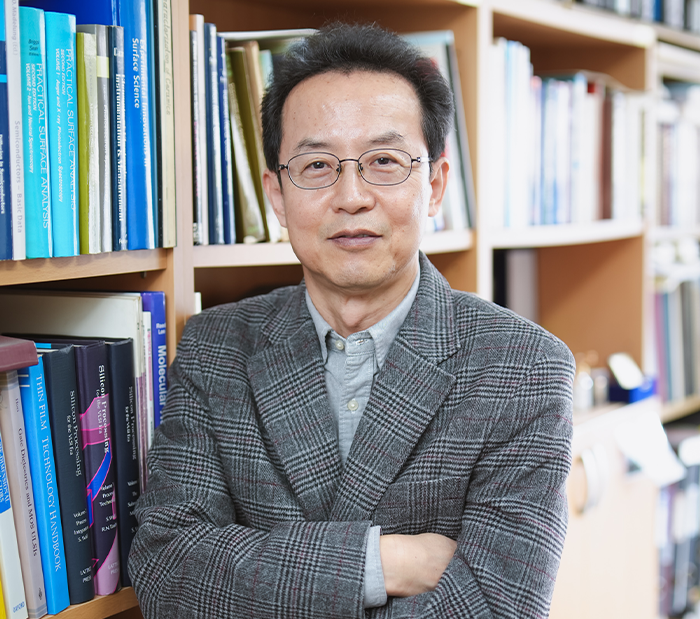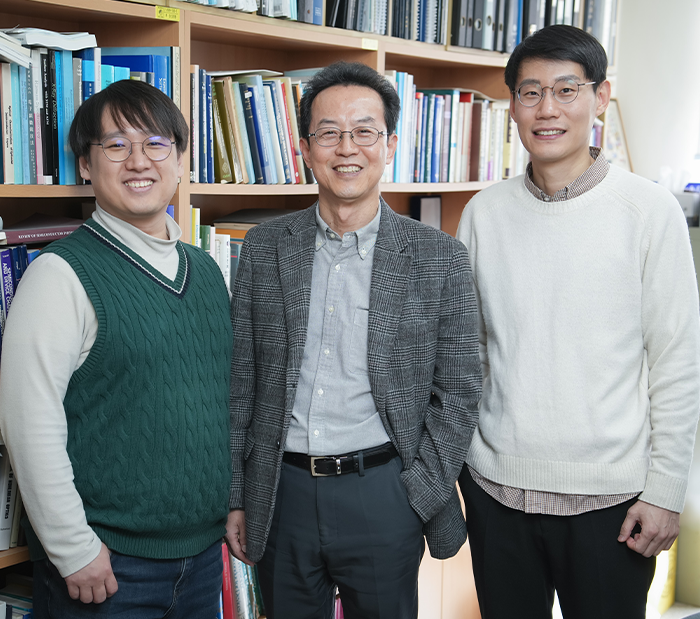Predicting and demonstrating of hidden metastable phase in transition metal oxide
Advanced Materials Science and Engineering LEE, JAICHAN Prof. · Bongwook Chung
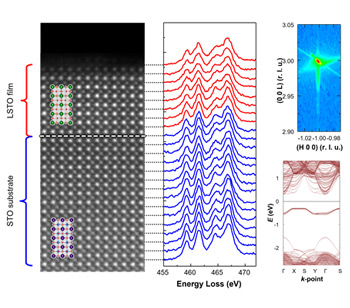
-
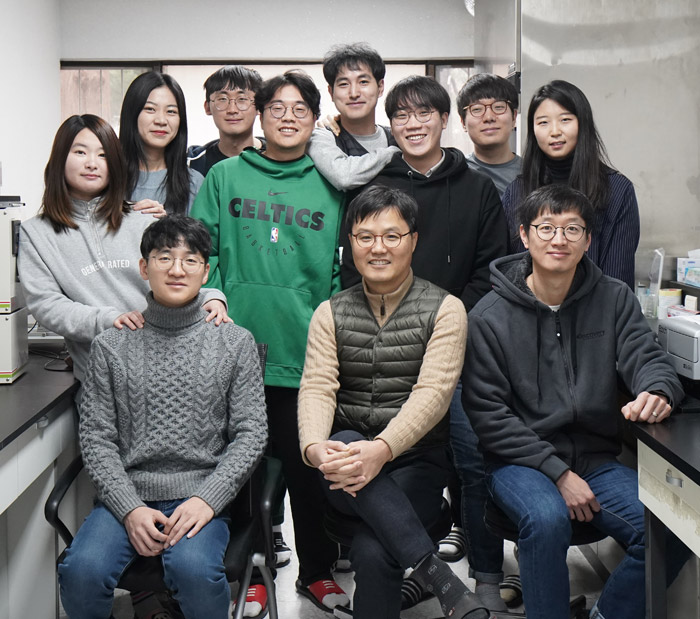
Bio-Mechatronic Engineering KIM, GEUNHYUNG Prof.
Successful Development of 3D muscle-mimetic cell-laden nanofiber via cell-electrospinning
Prof. Geun Hyung KIM and his research team reported that they have successfully aligned the nanofibrous structure by producing live myoblast cells and bioink suitable for electrospinning. Nano-muscular fibers implanted with live myoblast cells acted as if it were a real muscle tissue and accelerated the regeneration of muscle tissue by guiding the muscle cell to grow in a uniaxial direction. Tissue Regeneration Engineering is a field of study developed to improve the regeneration process of damaged tissues/organs by inserting a biological substitute, which is called scaffold. 3D cell-printing and electrospinning has been widely used for this process. However, the cells cultured by 3D cell-printing and electrospinning grew randomly, which was a serious problem for muscles that required its cells to be aligned for proper regeneration. To control cell morphology, they have developed electrospinning to a cell-electrospinning process. The research team used a biocompatible hydrogel to generate cell-laden nanofibers. Also, the hydrogel was added with a material with high processability to produce a bioink, which was applied with high-voltage direct current (Figure 1). After this, myoblast-laden nanofiber can be generated with an aligned pattern. -the myoblast-laden nanofibers showed over 90% of initial cell viability, which was a sign that it overcame the problem of low cell viability from the previous conventional cell-electrospinning process. Moreover, the cell alignment and differentiation improved threefold in comparison to the 3D cell-printing process (Figure 2). -the myoblast-laden nanofibers induced cells to grow in a uniaxial direction, which assists the regeneration of skeletal and cardiac muscle. Prof. KIM said, “This was the first case to successfully produce cell-laden nanofibers in uniaxial arrangement. It suggested a possibility to become a new method of regenerating aligned tissue structure.” This research was supported by a grant from the National Research Foundation of Korea funded by the Ministry of Education, Science, and Technology. It was featured in the world-renowned peer-reviewed scientific journal “Nano Letters” (impact factor 12.279) as well as “Biomaterials” (impact factor 10.273). Figure 1. Fabrication of regenerative muscle construct by controlling the alignment of nano-particles using flow induced shear force and electric field. Figure 2. Fabrication of regenerative muscle construct by providing the aligned dECM-Ma fibers using 3D cell printing process.
- No. 126
- 2019-12-26
- 3903
-
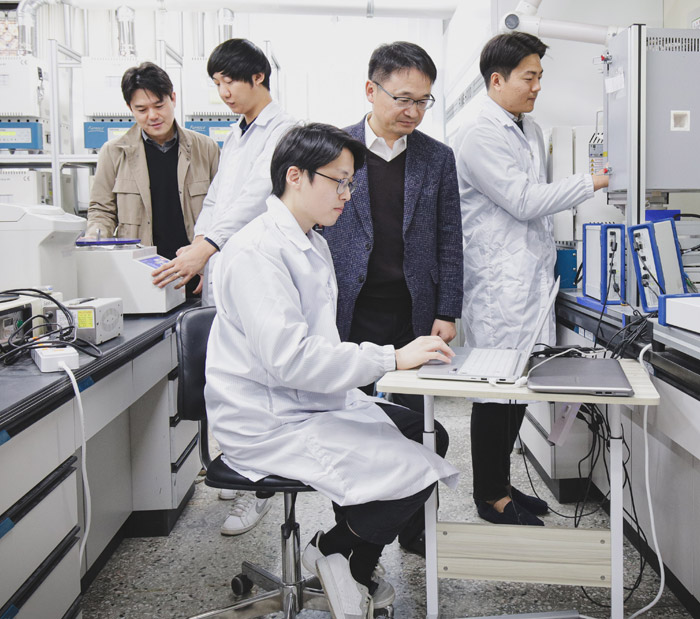
Mechanical Engineering LEE, WON YOUNG Prof.
Invention of nano-wrinkle functional layer using the ESD method
Prof. Wonyoung Lee and Prof. Doyoung Byun in the Department of Mechanical Engineering (First author: Jongseo Lee / co-first authors: Sangyeon Hwang, Minwoo Ahn) at SKKU announced the development of nano-wrinkle functional layer using the electrostatic spray deposition (ESD) method for the nanofiber electrode based solid oxide fuel cells. This research was published in Journal of Materials Chemistry A, one of the world's most prestigious journals in the energy field as a cover paper on August 2nd. This work is supported by the Technology Development Program to Solve Climate Changes (2017M1A2A2044927) and the Global Frontier R&D Program at the Center for Multiscale Energy System (Grant No. NRF-2014M3A6A7074784) and the Basic Science Research Program (NRF-2017R1E1A1A01075353) through the National Research Foundation (NRF) funded by the Ministry of Science, ICT & Future Planning. Also, it is supported by the National Research Foundation of Korea (NRF) grant funded by the Korean government (MSIP) (No. 2019R1A2C4070158). A unique nano-wrinkled functional layer was fabricated by ESD between a porous nanofiber electrode and a dense electrolyte to extend and activate reaction sites at the interfaces for the high-performance intermediate-temperature solid oxide fuel cells. Upon the introduction of the nano-wrinkled functional layer, the polarization resistance was reduced 3.3-fold, while the peak power density was increased 2.2-fold at 650 ºC, compared to those of the reference sample. The substantial increases in surface area and grain boundary density in the nano-wrinkled functional layer reduce both polarization resistance and activation energy, providing a significant performance enhancement. Our results demonstrate the importance of interface engineering with a cost-effective and simple ESD process to fully utilize the nanostructured electrodes for high-performance IT-SOFCs. Prof. Wonyoung Lee said, “The structural mismatches existed at the interfaces between the nano-structured electrode and the dense electrolyte could be overcome with the nano-wrinkled functional layer.” He continued, “ESD method can greatly contribute to developing technologies at the commercialization stage because it can provide the large-area and high-speed fabrication processes for a number of nano-structures."
- No. 125
- 2019-12-13
- 3341
-
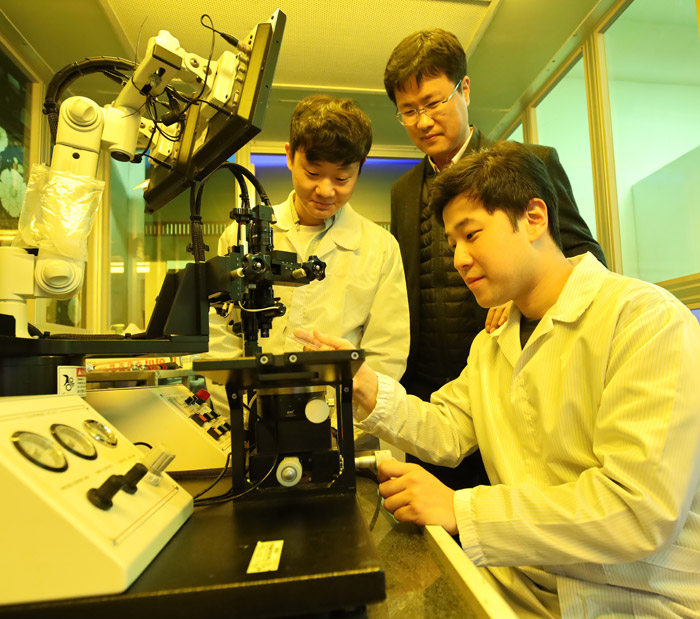
Chemical Engineering KIM, TAE IL Prof.
Bio-inspired Electronics for Enhancing Human Capability
Professor Tae-il Kim's research team combined biomimetic technology (technically reinterpreting the motifs obtained from natural structures) with flexible electronics (electronic devices assembled on a deformable substrate) to study new “bio-inspired electronics”. The team’s research has been conducted to overcome the limitations of the size and performance of existing bioelectronic devices using semiconductor-based processes and utilized in various artificial sensory organs (visual, tactile, auditory, etc.). [1] In particular, by presenting the world's smallest technologies such as artificial eardrums that simulate the spiders’ vibration receptors (lyriform slit organ) it can be an alternative technology to artificial snail tube devices (artificial cochlear implants), which are existing bio-devices. It is also useful for curvilinear structures such as the eyes, which can lead to the enhancement of human sensory organs. Related technologies can be combined with nerve interface technology to control or stimulate stress cortisol hormones by measuring or stimulating the electrical activity of nerves with biomimetic elements. In addition, the team presented hierarchical structures inspired by termite mound structures which have wonderful heat dissipation systems [2] and applied the flexible device to prevent thermal degradation and enhance the thermal response of the flexible electronic device. [3] The technology related to flexible biomimetic devices could be applied not only to bio-devices but also to rollable and foldable devices.[4] Based on such unique techniques and good insights, we have many alumni from R&D researchers in Samsung and LG to postdoctoral researchers at top-level universities. [1]. Yei Hwan Jung, B. Park, J.U. Kim, and Tae-il Kim*, "Bioinspired Electronics for artificial sensory systems" Adv. Mater. 31 (34) 183637 (Aug 2019) [impact factor 25.809] [2] Byeonghak Park, J.U. Kim, J. Kim, D. Tahk, C. Jeong, J. Ok, J. Shin, D. Kang, Tae-il Kim* "Strain-Visualization with Ultrasensitive Nanoscale Crack-based Sensor Assembled with Hierarchical Thermochromic Membrane" Adv. Funct. Mater. 29 (40) 1903360 (Oct 2019) [impact factor 15.621] [3]. Haeleen Hong, Y.H. Jung, J.S. Lee, C. Jeong, J.U. Kim, S. Lee, H. Ryu, H. Kim, and Tae-il Kim*, "Anisotropic thermal conductive composite by guided assembly of boron nitride nanosheets for flexible and stretchable electronics", Adv. Funct. Mater. 29 (37) 1902575 (Sep 2019) [impact factor 15.621] [4]. Chanho Jeong, J.S. Lee, B. Park, C.S. Hong, J.U. Kim and Tae-il Kim*, "Controllable Configuration of Sensing Band in a Pressure-Sensor by Lenticular Pattern Deformation on Designated Electrodes", Adv. Mater. 31 (36), 1902689 (Sep 2019) [impact factor 25.809]
- No. 124
- 2019-12-06
- 3241
-
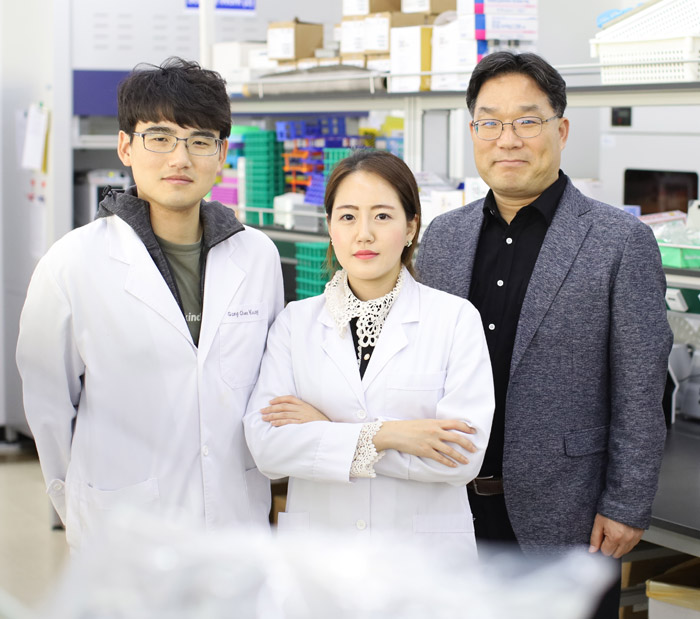
SKKU Advanced Institute of Nano Technology LIM, YONGTAIK Prof.
Reverting “Cold tumors” into “Hot tumors” by ImmunoBioengineering
Prof. Yong Taik Lim’s group of Sungkyunkwan university reported that 2 different immune nano converters that can overcome the limitation of immune checkpoint inhibitors which is related to the 2018 Nobel Prize in Physiology and Medicine (Advanced Materials, September 6 / ACS nano, October 7 Online publication). Although immune checkpoint inhibitors (Anti-CTLA4, Anti-PD-1, and Anti-PD-L1, etc) are highly attracted as promising immunotherapeutic, the response rate is very low, which ranges from approximately 5~30% depending on the target tumors. The reason for this is that various immunosuppressive factors in the tumor microenvironment hindered activation of the therapeutic immune cells. To overcome this, many pharmaceutical companies around the world are focusing on developing treatment technologies to improve the response rate of immune checkpoint inhibitor. The key technologies to increase the response rate to immune checkpoint inhibitors are inducing differentiation and proliferation of antigen-specific T cells, which actually kill cancer cells, and controlling immunosuppressive cells (MDSC, TAM, and Treg) and immunosuppressive cytokines (TGF-β and IL-10) in tumor microenvironment. By controlling the function of immunosuppressive cells present in the tumor microenvironment, “cold tumor” that does not respond to immune checkpoint inhibitors can be reverted to “hot tumor” that does respond immune checkpoint inhibitors and activation of therapeutic dendritic cells, T cells and macrophage cells. In this study, the release of resiquimod (R848) was controlled from 2 different immune nano converters to reduce systemic toxicity. The two platform technologies in this study were 1) developed in a implantable disc to prevent recurrence and metastasis of cancer in situations where the cancer is not completely removed by surgery, 2) lyophilizable nanoemulsion that can be applied to cancer immunotherapy as well as infectious diseases. The two newly developed platforms are developed as biocompatible materials that have been approved for human and are highly likely to be clinically approved. Two platform technologies are expected as personalized cancer vaccines that can be loaded personalized cancer drug and neo-antigen from cancer patients to enhanced immune checkpoint inhibitor respond rates through the analysis of various immunological factors in each cancer patients. Paper title: Designer scaffold with immune nanoconverters for reverting immunosuppression and enhancing immune checkpoint blockade therapy (Advanced Materials, September 6, 2019) Paper title: Lyophilizable and Multifaceted Toll-Like Receptor 7/8 Agonist-Loaded Nanoemulsion for the Reprogramming of Tumor Microenvironments and Enhanced Cancer Immunotherapy (ACS nano, October 7, 2019)
- No. 123
- 2019-11-13
- 3572
-
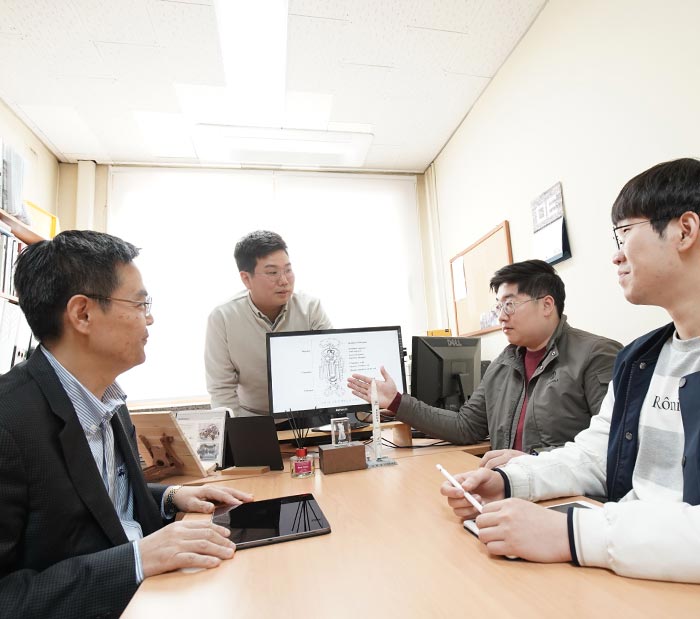
Mechanical Engineering KWON, OHCHAE Prof.
New Method for Evaluating the Combustion Stability of Hydrogen/Oxygen Bipropellant
Oh Chae Kwon, professor of mechanical engineering, has suggested a method for evaluating the combustion stability of hydrogen/oxygen bipropellant. It is expected to be a fundamental technology for the diversification of liquid rockets propellants in Korea.The results of the research that was supported by the space core technology program promoted by the Ministry of Science and ICT and the National Research Foundation of Korea have been published on August 1 in the print edition of 'Energy'. Turbulent combustion is a complex process involving a wide range of length scales. In order to comprehend turbulent combustion phenomena in rocket engines, it is needed to investigate the turbulence-chemistry interaction that determines the flame-front structure. While the combustion characteristics of kerosene/ oxygen propellants have been recently investigated in Korea, however, the combustion characteristics of the hydrogen propellant have not been extensively studied. Hydrogen propellant which has been highlighted as a propellant of reusable rockets has various advantages such as high specific impulse and eco-friendly features compared with other conventional liquid bipropellants such as kerosene. Thus, hydrogen propellant has been used for commercial rocket engines in other countries and has the potential to be developed in Korea. His research team conducted combustion experiments, measuring combustion stability limits using a high-pressure model combustor which is designed to endure pressure up to 60 bar and a propellant supply facility capable of feeding cryogenic liquid oxygen in order to simulate actual rocket engine operating conditions. The combustion stability limits such as flame extinction and instability are directly related to the stability of rocket engines, and the results can be used for the baseline data of hydrogen rocket engine design. They analyzed the mixing and spray characteristics in various injection conditions by changing temperature, pressure, phase and injection velocity and investigated the combustion characteristics by visualizing flames. A new method to estimate Damkohler number (Da) using the flame visualization was suggested. The proposed modified Da provides the limits for the occurrence of combustion instability. A regime diagram has been constructed through the mapping of flame structure onto a two-dimensional plot. This achievement is meaningful in that it provides criteria for evaluating the combustion characteristics of propellants in general, even if the variables related to combustion such as the size of the combustion chamber, propellant flow rate, propellant injection velocity and propellant type are changed. Combustion stability limits which are measured under specific experimental conditions seem to be difficult to be used in evaluating actual rocket engines with different conditions. This dimensionless number which was applied to gas turbines and boilers can also be used for the evaluation of liquid rocket engines as well.
- No. 122
- 2019-11-04
- 3072
-
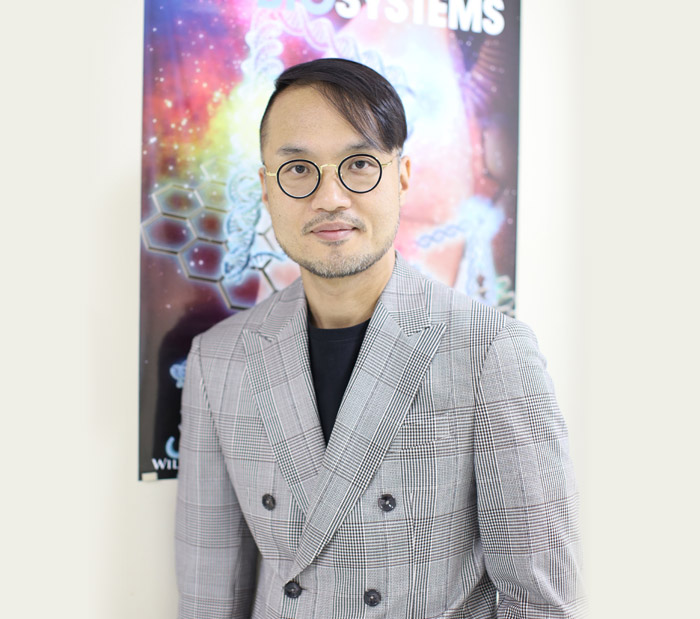
Chemical Engineering UM, SOONG HO Prof. ·Researcher YUK, JISOO
Lung cancer can be quickly diagnosed at low cost
Sungkyunkwan University (President: Dong Ryeol SHIN) announced on July 17 that Prof. Soong Ho UM from the Dept. of Chemical Engineering and Prof. Myung Ju AHN from the Dept. of Hematology and Oncology of SKKU Medical School have identified ways to dramatically improve lung cancer diagnosis. The previous lung cancer screenings took about three weeks with high cost, but as result of this research, it is expected to be diagnosed in vitro within about three hours at low cost. The researchers developed a high-performance nucleic acid nanostructure-graphene oxide complex and realized a high-speed, real-time, and multi-diagnosis of specific gene combinations of lung cancer disease without PCR. The time required for cancer diagnosis was dramatically shortened and applied to liquid biopsy, which is emerging as a non-invasive and patient-friendly cancer diagnosis method. As a result, simultaneous diagnosis of multiple biomarkers of lung cancer applicable to liquid biopsy has opened the possibility of establishing a phased lung cancer treatment model. The first author, Ms. Ji Soo YUK, developed a nucleic acid structure-graphene oxide platform that selectively discriminates the combination of epidermal growth factor receptor (EGFR), a representative biomarker and microRNAs for lung cancer. They are well known as cancer cell fingerprint genes that contain information about the process of cancer cell progress. This platform also enables the distinction of point mutations that show a difference in one single gene mutation. In addition, multiple biomarkers are determined in real time within 3 hours, so that ultra-simplicity and ultra-precision cancer diagnosis can be performed. The mutation of a specific gene or the change in the expression rate of genetic materials is thought to affect the development and progression of cancer. In the case of lung cancer, EGFR gene mutation is a typical biomarker, and 35 ~ 50% of Asian patients are similar. Recently, it has been attracting much attention because it is known that the expression of microRNA (as well as EGFR mutants) directly affects the production of cancer tumor. To detect these genes, target biomaterial samples should be secured by invasive and surgical methods. This causes considerable physical and mental pain for the patient and the utilization of technology is significantly limited depending on the location of the tumor. In addition, the genetic testing process takes weeks after tissue collection. Therefore, a patient-friendly diagnostic method is urgently required to evaluate the suitability and resistance of each patient's drug in a comprehensive manner. In this study, a high-speed diagnostic platform applicable to blood was developed. The mutation of the EGFR gene can be used actively in clinical prescription of the therapeutic agent, and simultaneous identification of the microRNA group will contribute greatly to the discovery and treatment of new cancer biomarkers. The researchers have built a nano-barcoding platform system with a new nano-hybrid material between a fluorescent nucleic acid biopolymer and graphene oxide in a triangular column model. The system is designed to selectively respond to microRNAs originating from lung cancer and specific gene biomarkers such as EGFR mutants, and specific fluorescent switches are designed to react and turn on in the presence of a specific biomarker. This is applicable to various gene biomarkers at the same time and is diagnosed in vitro, so it can be used in various aspects such as gene diagnosis and prevention kit in clinical practice. In fact, we have solved the comprehensive problems of clinical kits and have explored the possibility of precision medicine for the first time. This reagent type platform is commercialized under the name of 'FluorgraTM' in DNANO Inc. (President: Young Ku Lee). “The short-term screening time and the applicability to liquid biopsy are enabling real-time monitoring of drug efficacy in conjunction with fast prescriptions for clinical diagnosis, and thus customized treatment for patients is being realized,” said Professor Soong Ho UM. “This will evolve into a form like a commercialized pregnancy diagnosis kit and provide convenience for health and welfare in daily life as soon as possible.”
- No. 121
- 2019-10-21
- 3658
-
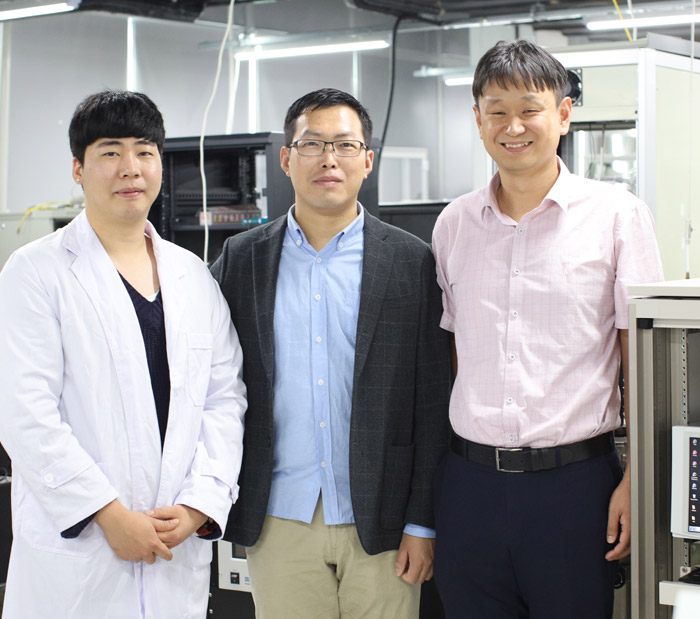
Energy Science YANG, HEEJUN Prof. ·Researcher SUN LINFENG
Ultrafast, ultralow power consuming terabit-scale memory integration based on 2D materials
Prof. YANG’s research group recently reported a new conceptual memory system that can be integrated up to terabit-scale by using 2D graphene and h-BN. The 2D memory device operates with an ultralow power (micro-Jules) and a time constant of tens of nanoseconds, which is 100 times faster than current non-volatile memory devices (e.g., flash memory). Unlike conventional phase change memory (PRAM) or resistance random access memory (RRAM), such high device integration with 2D materials has demonstrated various fabrication and materials issues. Moreover, most 2D semiconductors have shown not-reliable operations. Prof. YANG’s team conceived a new conceptual memory device: combining volatile and non-volatile memory devices based on representative and most stable 2D materials; graphene and h-BN. Thus, the self-selective memory does not require a ‘selector device’ that is essential for other integrated devices. Moreover, the 2D materials allow device operation with 1000 times lower power consumption and 100 faster speed. Quantum tunneling through the 2D insulator and a reliable filament formation at the inert graphene were used for the operation. Prof. YANG mentioned that the ‘self-selective memory’ is the first case to demonstrate the feasibility for large-scale memory device integration with 2D materials. While conventional oxide materials show the limitations on the operating power and speed, the self-selective memory will be widely used for the future memory applications in AI and other neuromorphic industry. This research has been published in Nature Communications (IF=11.880) on July 18, 2019. Self-selective memory with graphene and h-BN. A memory of ‘SKKU’ with 25 memory cells are demonstrated.
- No. 120
- 2019-10-07
- 4073
-
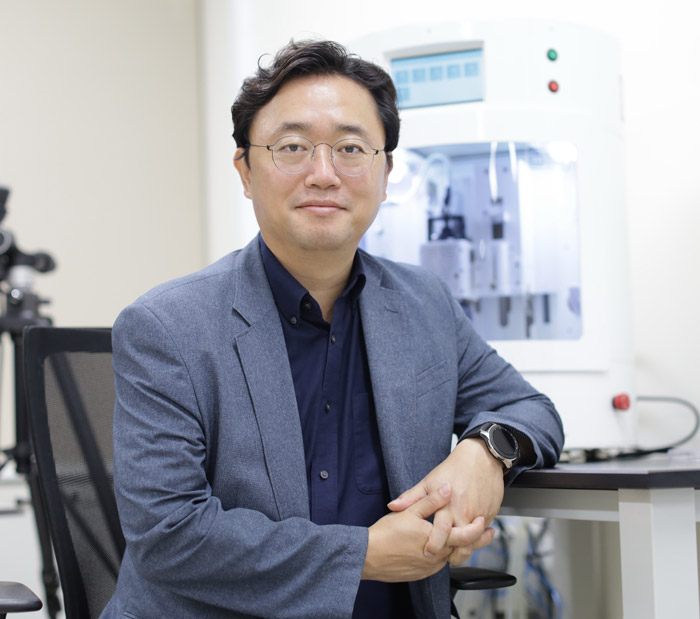
Advanced Materials Science and Engineering KIM, SANGWOO Prof. ·Prof. Hongjoon YOON · Ronan HINCHET
Triboelectricity for charging medical implants
Electronic implants offer many benefits but they are all powered by batteries that need to be replaced regularly through surgery, resulting in additional risks and costs. In this regard, powering medical implants is of great interest. Korean researchers at Sungkyunkwan University (SKKU) reported energy harvesting technology driven by ultrasound. Their study will be published through the journal Science on August 2nd. Ultrasound, transmitted through the skin, makes Perfluoroalkoxy (PFA) membrane vibrate with about 200 μm of displacement at 20 kHz. Under ultrasound excitation, the membrane vibrates in a multimode, which ultimately induces continuous triboelectrification. Prof. Sang-Woo Kim's research team suggested the triboelectric energy harvesting technology driven by transcutaneous ultrasound for powering medical implants. His group demonstrated mechanical energy harvesting by ultrasound using a rat skin. They also discovered that harvesting in a porcine tissue is feasible with vibrating and implantable triboelectric generator (VI-TEG). On top of that, they successfully charged Li-ion battery by taking advantage of the triboelectric generators for the first time. Prof. KIM stated that "We showed for the first time the triboelectrification inside the body induced by transcutaneous ultrasound, which enables powering biomedical implants in safe and convenience manner." "We believe that our findings will be influential on future medical implants market." [Reference] R. Hinchet et al., (2019) “Transcutaneous ultrasound energy harvesting using capacitive triboelectric technology.” Science [Main Author] Hong-Joon YOON (Sungkyunkwan University), Sang-Woo KIM (Sungkyunkwan University) * Contact email: Professor Sang-Woo KIM (kimsw1@skku.edu)
- No. 119
- 2019-09-16
- 4184
-
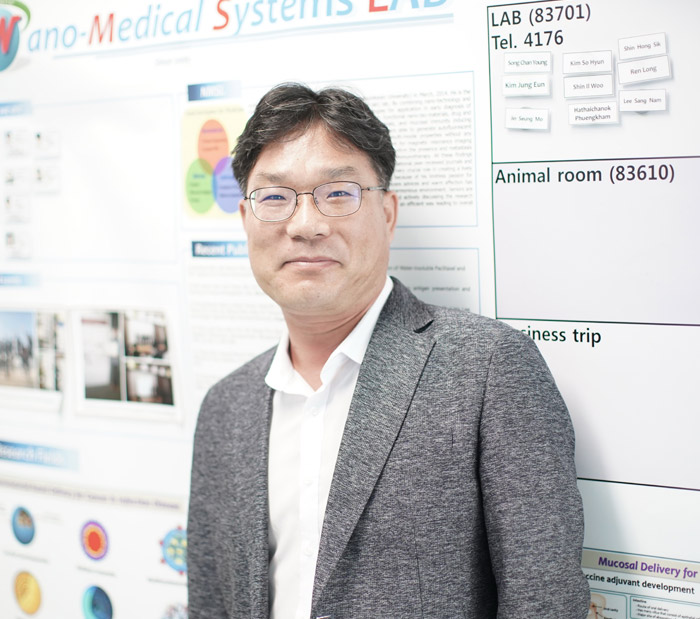
SKKU Advanced Institute of Nano Technology LIM, YONGTAIK Prof. ·SONG, CHANYOUNG
Syringeable immunotherapeutic nanogel reshapes tumor microenvironment and prevents tumor metastasis and recurrence
Surgery maintains its strong position as a therapeutic modality for treating established solid tumors, and various immunotherapies, such as cancer vaccines and checkpoint therapies. Adoptive T cell transfer are applied to treat residual tumors after surgery and prevent tumor recurrence and metastasis. However, immunotherapies have a low response rate, which ranges from approximately 5-30% depending on the target tumor. Recently, Prof. Yong Taik LIM’s research team from Sungkyunkwan University reported a syringeable immunomodulatory multidomain nanogel (iGel) that overcame the limitation by reprogramming the pro-tumoral tumor microenvironment (TME) to antitumoral immune niches. Local and extended release of immunomodulatory drugs from iGel deplete immunosuppressive cells, while inducing immunogenic cell death, it increased immunogenicity. When iGel is applied as a local postsurgical treatment, both systemic antitumor immunity and a memory T cell response are generated, and the recurrence and metastasis of tumors to lungs and other organs are significantly inhibited. Reshaping of the TME using iGel also reverts non-responding groups to checkpoint blockade therapies into responding groups. The iGel is expected as an immunotherapeutic platform that can reshape immunosuppressive TMEs and synergize cancer immunotherapy with checkpoint therapies, with minimized systemic toxicity. Thesis Title: Syringeable immunotherapeutic nanogel reshapes tumor microenvironment and prevents tumor metastasis and recurrence
- No. 118
- 2019-09-03
- 3900
-
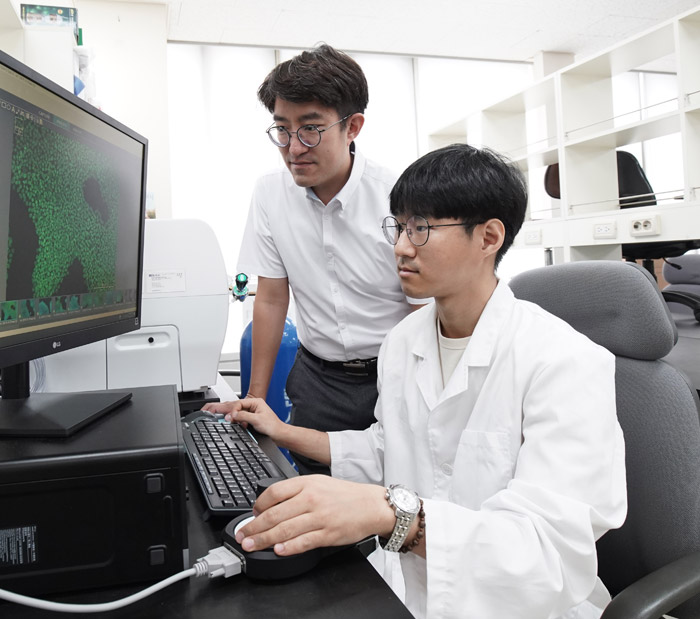
Pharmacy LEE, JAE CHEOL Prof.
Identification of molecular mechanism of dilated cardiomyopathy
Professor Jaecheol LEE’s research team (School of Pharmacy) announced that they identified molecular mechanism of dilated cardiomyopathy(DCM) and provided potential drug target using patient-specific induced pluripotent stem cells (iPSCs). Dilated cardiomyopathy (DCM) due to myocardial abnormality is a syndrome accompanied by ventricular dilatation and contraction dysfunction. It has a high prevalence rate of 1 to 2 per 100,000 Korean, but the precise mechanism is unknown. The researchers looked into the cause of the DCM by generating iPSC from family with DCM and differentiating their iPSCs into cardiomyocytes (iPSC-CMs). They observed abnormal nuclear structures in iPSC-CMs with LMNA mutation. On the contrary, nuclear structure is returned to normal when the LMNA mutation was corrected through genome editing technique. They found that abnormal nuclear structure of mutant iPSC-CMs causes the genome-wide epigenetic changes and eventually leads to the activation of platelet-derived growth factor (PDGF) signal pathway that is silenced in normal iPSC-CMs. The results suggest the novel therapeutic targets of DCM by applying some existing drugs approved by US Food and Drug Administration (FDA)in their disease model system. Professor Jaecheol LEE said, "In the era of precision medicine, which can predict diseases through massive genetic information ofpatients, it is necessary to have a technique to experimentally verify such aprediction system” "Our study demonstrates the potential of patient-specific iPSCs system not only for the modeling the specific diseases but also developing new drug for cardiovascular diseases”. This research was supported by Ministry of Science and ICT and National Research Foundation of Korea. It was published online in the world renowned journal “Nature”.
- No. 117
- 2019-08-19
- 3580
-
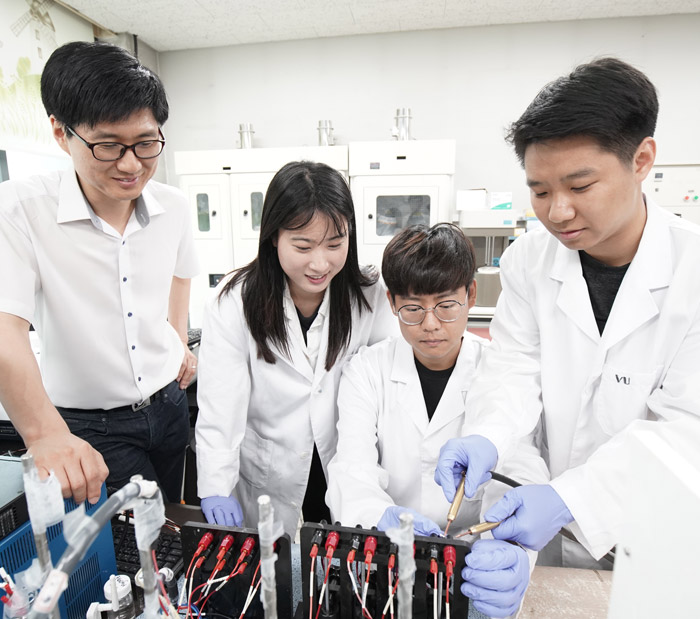
Chemical Engineering PARK, HOSEOK Prof.
First in the world to develop energy storing mechanism of two-dimensional graphene/phosphorene
Development of Radially Assembled Graphene Microspheres with Sulfur-Nanorods for Lithium-Sulfur Batteries Researchers from Sungkyunkwan University have developed the sulfur nanorods immobilized on radially assembled open-porous graphene microspheres cathode material for Lithium-Sulfur Batteries (LSB). This research was published online on March 12 on ACS Nano. LSB, which have received much attention as a next-generation battery, had some problem to overcome before commercialization, such as low conductivity of sulfur, volume expansion, and shuttle effect. The research team first demonstrated rod-like nanosulfur strongly interacting with hierarchical radiaaly assembled open-porous spherical rGO, which are synthesized through controllable spray-frozen (SF) assembly. In the synthesized composite (rGO/nS), uniformly rod-like sulfur nanoparticles are distrubuted in the areas that formed a strong bond between surface of graphene and sulfur, greatly improving stability of LSB. In addition, the radially open-pore type spherical structure made electrolyte penetration easier, enhancing utilization of sulfur. The synergistic effect of the two have shown excellent stability, and high performance in LSB. As a result, The rGO/nS hybrid provides a specific capacity and first-cycle Coulombic efficiency of 1269.1 mAh/g and 98.5%, respectively. A 4C capacity of 510.3 mAh/g and capacity decay of 0.08% per cycle over 500 cycles. “This synthesis method is a new technology that allows granulation in the ball shape of micro-sized regardless of the type of nanomaterials, while simultaneously controlling the open-porous structure and ball shape.” explained Prof. Ho Seok Park, the corresponding author. Moreover, “it will help to offer a solution that can push ahead with the commercialization of LSB in the future.”, he added. (a) Schematic illustrations about the synthetic procedures of radially oriented open-porous spherical R-rGO/nS and (b) Long-term cycle stability data at 0.1C and Coulombic efficiencies of R-rGO/nS. MXene/Polymer Hybrid Materials for Flexible AC Filtering Electrochemical Capacitors SKKU researchers have successfully realized high volumetric capacitance along with the high-frequency response, and turned the electrochemical capacitor (EC) technology successfully towards the development of form-factor-free miniature and scalable systems for Alternating current (AC) filtering application and energy storage system for pulse energy harvesters. This research was published online on November 8th 2018 in Joule Cell-Press(2019,3,164-176). Aluminum electrolytic capacitors (AECs) have been used as power devices for AC filtering applications, and are critical for the IoT (internet of things) and self-powered wearable sensors. The capacitance of AECs is much lower than that of ECs, called supercapacitor or ultracapacitor. The rigid shape and bulkiness of AECs are obstacles for their use in miniature and flexible systems. Therefore, the development of flexible ECs that provide high volumetric capacitance and operate in the frequency range of AECs would have an enormous impact. This work carried out systematic approaches to tackle different issues of ECs to replace AECs and open up the opportunities for its further development. Particularly to tackle the issue, the porous MXene/conducting polymer hybrid thin films have been produced, which has an interconnected network structure at the optimum composition and thickness. This maximized the charge transport properties and storage capability of the MXene hybrid thin films, areal and volumetric capacitances of 0.56 mF cm-2and24.2Fcm-3 at 120Hz and enabling operation even at a rate of 1,000Vs-1 or from 60 to 10,000Hz, with extreme flexibility and durability. Additionally, Prof. Ho Seok Park claimed that, “the used coating method is scalable and prepared hybrid electrodes are mechanical robust, so readily available recipe to support self-powered wearable electronics through commercialization”. (A) This Figure was selected as the cover image in Joule, (2019), Volume 3, Issue 1, p1-p304. (B) Schematic representation of synthesis approach and digital photographs showing scalability and mechanical features of prepared electrodes. (C) Areal capacitance and (D) AC filtering capability of prepared ECs at different frequencies. (E) Long-term cycle stability of ECs in different mechanical states. Extrinsic Pseudocapacitance of Molecular-Level Controllably Oxidized Black Phosphorus Nanosheets Researchers from Sungkyunkwan University have discovered the new functionalities on the surface of black phosphorus (BP) nanosheets through chemically controlled functionalization at the molecular-level, revealing the new charge storage mechanism, that improves the overall electrochemical performance. The story of this work was published online on December 10 on Nature Materials. Supercapacitor is one of the promising energy storage devices due to its high power density. However, there are clear limitations such as low energy density and poor rate capabilities. Thus, the new storage mechanism of extrinsic pseudocapacitors, storing charges through redox reaction at surface or near surface, is considered to become a candidate of next-generation energy storage devices. This research team has found that P=O sites has an ability for surface redox charge storage. Increasing of P=O sites concentration can provide more capacitance and energy density. However, too much concentration of active P=O sites can drop the electronic conductivity. Therefore, this research work demonstrated the chemical strategy of molecular-level selective ozone driven oxidation to reveal a unique extrinsic pseudocapacitive mechanism of P sites on oxidized BP nanosheets, that are strongly coupled with graphene via strong interlayer bonding. Through this approach, the higher P=O sites concentration can be achieved, while preserving the electronic conductivity as well, resulting in the oxidized BP/graphene hybrid achieves a capacitance of 478 F/g (four times greater than 2D BP) with a rate capability of ~72% (compared to 21.2% for 2D BP) and capacitance retention of ~91% (with high reversibility, 99.6% coulombic efficiency) over 50,000 cycles. “This work demonstrated a truly reversible pseudocapacitance of oxidized P sites for the first time using controlled oxidation and strong interfacial coupling of oxidized BP and graphene, offering the great solution to electrochemical energy storage communities to improve capacitance, rate capabilities as well as cyclic stability.” explained Prof. Ho Seok Park, the corresponding author. (a) Schematic illustration of the molecular-level controlled chemical approach for oxidized BP/graphene hybrid. (b) Electrochemical performance of oxidized BP/graphene hybrid (foBG) compared to oxidized BP/graphene non-hybrid (oBGP), rGO, and 2D BP.
- No. 116
- 2019-08-05
- 4003
-
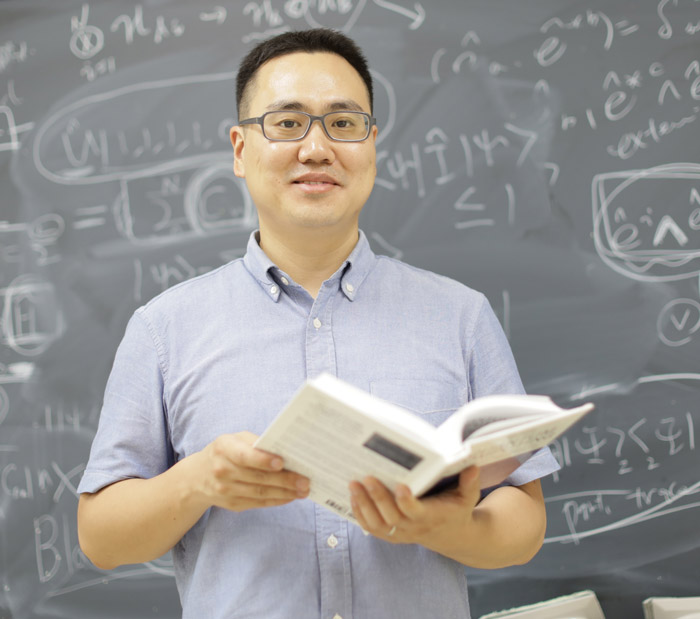
Chemistry HUH, JOONSUK Prof.
Quantum Algorithm for Calculating Molecular Vibronic Spectra
Recently, not only academics but also industries such as Google, IBM, and Intel are interested in quantum computation research. We expect a prototype quantum computer, which can outperform classical computers in 10 years. Among the various applications of quantum computing, quantum computational chemistry would become a major application area of quantum computing. Prof. Huh has been developing quantum simulation method for molecular vibronic spectroscopy for non-universal quantum computers. In this work, an efficient quantum algorithm for the molecular vibronic spectroscopy, which can be operated in the universal quantum computer, was developed. This new quantum algorithm based on the quantum phase estimation algorithm can be applied to more complicated molecular quantum anharmonic oscillator problems. Quantum algorithm for calculating molecular vibronic spectra Classical simulation of quantum algorithm for calculating molecular vibronic spectra
- No. 115
- 2019-07-24
- 3517


